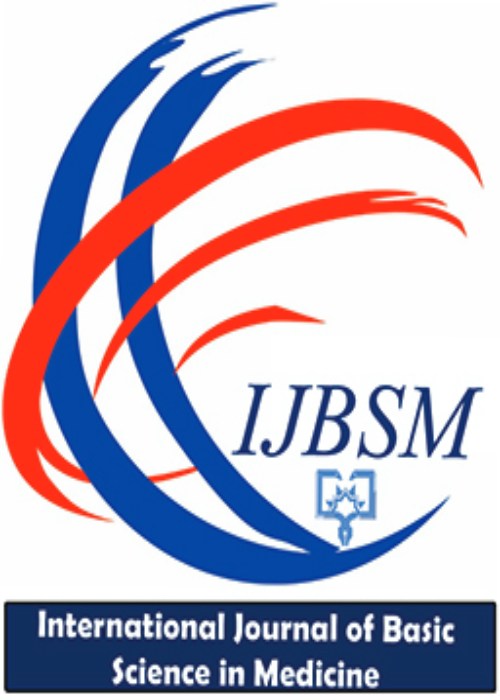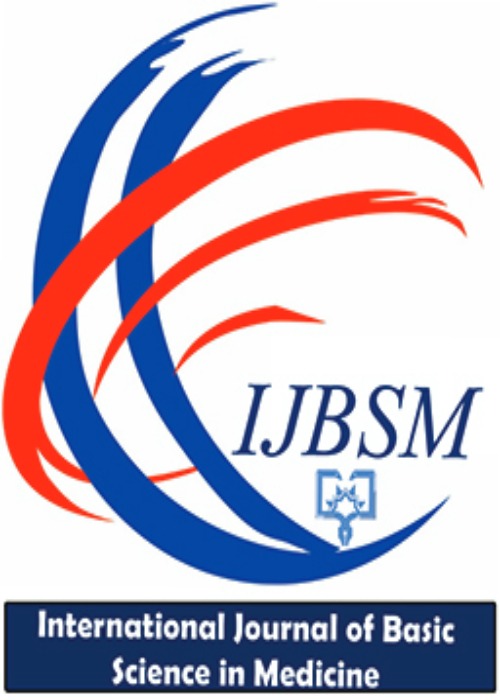فهرست مطالب

International journal of basic science in medicine
Volume:7 Issue: 3, Sep 2022
- تاریخ انتشار: 1401/08/30
- تعداد عناوین: 8
-
-
Pages 96-97
-
Pages 98-103
The coronavirus disease 19 (COVID-19) outbreak in Wuhan, Hubei province, is a global health problem affecting about 212 countries around the world, highlighting the importance of the global recruitment of scientists to find a way for managing this burden. So far, many studies have been conducted to find a treatment for COVID-19, some of which indicated promising results. In this situation, gathering the previously published evidence may provide new hypotheses/ solutions in this regard. Based on the role of inflammation in COVID-19-related deaths, we attempted to find a rational relationship between Janus kinase/signal transducer and activator of transcription (JAK/STAT) signaling and COVID-19 and inform JAK/STAT signaling inhibitors as candidates to manage or even prevent severe acute respiratory syndrome coronavirus 2 (SARSCoV- 2) infection. Therefore, it is hoped that the present study provides new clues about the relationship between JAK/STAT signaling and the SARS-CoV-2 infection to highlight the role of JAK/STAT inhibitors as a possible treatment for managing inflammatory situations observed in the SARS-CoV-2 infection.
Keywords: Inflammation, JAK, STAT pathway, COVID-19 -
Pages 104-107
The novel coronavirus disease 2019 (COVID-19) pandemic which emanated from Wuhan, China, and its successive spread across the globe had a tremendous impact on virtually all spheres of human endeavors such as economy, health, livelihood, and education amongst others. The widespread restrictions currently placed on movement and mass gatherings have made educational and academic activities to be grounded globally. In recent years, the concept of learning has gradually transformed from traditional classroom methods to online learning where students acquire knowledge through invisible classrooms. Most learning institutions in Africa may encounter difficulties in turning to this new form of learning due to the lack of information and communication technology (ICT) facilities of international standards. Although many students today possess internet-enabled devices, they cannot access the internet due to unaffordable data subscriptions, which have made most learners use their devices for noneducational purposes. As the COVID-19 pandemic continues to ravage the African continent, the possibility to re-open the schools remains bleak. Thus, governments, authorities, and regulatory bodies in individual countries must improve their existing ICT infrastructures for a better online learning experience. This paper serves as a wake-up call for Africa and its educational sector to transit to online learning.
Keywords: Africa, COVID-19, Online learning, Education, Pandemic -
Pages 108-113Introduction
The link between Alzheimer’s disease (AD) and heart disease has recently been reported. Previous studies have reported the beneficial role of endurance training (ET) and saffron (Sa) on the heart and nervous system health, but their interactive effect is not yet well known. Therefore, the aim of this study was to determine changes in some observational cardiac parameters and cardiac PGC1-α expression after 8 weeks of ET and Sa consumption in animal models of AD.
MethodsIn this experimental trial, 40 rats with AD (by intraperitoneal injection of 8 mg/kg neurotoxin trimethyltin) were divided into (1) AD, (2) sham (Sh), (3) Sa, (4) ET, and (5) ET + Sa groups. Additionally, to evaluate the effect of AD induction on the research variables, 8 healthy rats were included in the healthy control (HC) group. Groups 4 and 5 ran for 8 weeks, three 15-30 minute sessions per week at a speed of 20-15 m/min. Groups 3 and 5 received 25 mg/ kg aqueous extract of Sa peritoneally each day. To analyze the data, dependent samples t test, one-way analysis of variance and Tukey’s post hoc test, analysis of covariance with Bonferroni’s post hoc test in SPSS version 22.0 were used (P ≥ 0.05).
ResultsIn the Sa and ET + Sa groups, heart weight, heart weight to body weight ratio, and cardiac PGC1-α expression were higher and the body weight of these groups was significantly lower compared with the AD group (P ≤ 0.05). Moreover, in the ET group, heart weight was higher than body weight and total body weight was lower compared to the AD group (P ≤ 0.05).
ConclusionIt seems that Sa and ET + Sa interaction improve heart function and some parameters related to heart health by increasing PGC1-α expression, but the effect of training depends on its type and intensity, which should be further studied.
Keywords: Endurance training, Crocus sativus, PGC1-α, Heart, Alzheimer’s disease -
Pages 114-120Introduction
This study aimed to evaluate the potential apoptotic effects of Zingiber officinale Roscoe (ginger) and Rosmarinus Officinalis L. (rosemary) combination extracts on the mouse colorectal cancer cell line.
MethodsAfter the preparation of the extracts, cytotoxicity and cell viability were measured by MTT assay, and the IC50 of each extract was calculated. Next, the combination index (CI) of the mixture of the extracts was evaluated by CompuSyn software. The apoptosis induction was evaluated by Annexin V/PI assay and caspase-3, Bcl-2, and Bax genes expression.
ResultsThe viability of the CT-26 cells exposed to ginger and rosemary extracts was significantly reduced in a dose-dependent manner (P < 0.05) with the confirmed synergistic effect of the mixture (CI = 0.89). Moreover, treatment of the cells with IC50 concentration of the extracts induced apoptosis, especially in the mixture group (P < 0.001). Additionally, expression levels of Bax and caspase-3 genes increased in the mixture group compared to the control (P < 0.001). Expression levels of Bcl-2 were increased in the rosemary and mixture groups compared to the control group (P < 0.05).
ConclusionThe results of the present study revealed that the mixture of the extracts has synergistic cytotoxic and apoptotic effects on colorectal cancer cells. Therefore, the mixture of ginger and rosemary extracts can be used as a potential complementary therapy in the context of other therapeutic approaches for colorectal cancer.
Keywords: Apoptosis, Colorectal cancer, Rosemary, Ginger -
Pages 121-127Introduction
Many diseases associated with oxidative stress threaten human health, exaggerated by antibiotic-resistant bacterial infections due to the increasing use of antibiotics. The aim of the present study was to evaluate the antioxidant and antimicrobial activities of a nanoemulsion prepared from Artemisia vulgaris essential oil (EO).
MethodsPoly (lactic-co-glycolic acid) (PLGA) nanoparticles (NPs) were synthesized in this study. The disk diffusion method, minimum inhibitory concentration (MIC), and minimum bactericidal concentration (MBC) were used to investigate the antibacterial properties of the synthesized NPs. In addition, the microdilution method was utilized to examine the antimicrobial properties of the synthetic substance. Inhibitory concentrations (MIC and MBC) were determined against Staphylococcus aureus, Micrococcus luteus, Escherichia coli, and Klebsiella pneumoniae. Finally, the antioxidant activity of the nanoemulsion was evaluated using the 1,1-diphenyl-2- picryl-hydrazyl biochemical method.
ResultsThe findings of this study demonstrated that the synthesized NPs had significant growth inhibitory effects against Gram-positive bacteria with considerable inhibition of growth being observed for S. aureus and M. luteus.
ConclusionIn general, Artemisia EO seems to be beneficial for treating bacterial infections owing to its antimicrobial properties and antioxidant effects. Further therapeutic applications of this EO as a potential drug carrier are yet to be divulged in future studies.
Keywords: Artemisia essential oil, Nanoemulsion, Antibacterial, Antioxidant -
Pages 128-132
Introduction: Exercise and the use of herbal supplements are among the therapeutic interventions in controlling type 2 diabetes. This study aimed to compare the effect of exercise and karela supplement on glycemic control and metabolic complications in patients with type 2 diabetes. Methods: In the present quasi-experimental study, 120 patients with type 2 diabetes were selected by purposive sampling and were randomly divided into 4 groups of exercise, karela supplement, combined, and control. Exercises included 8-week pyramid aerobic training, 3 sessions per week. Karela was consumed in a dose of 50 mg/kg body weight daily in form of karela powder. Results: There was a significant decrease in fasting blood sugar (FBS), 2-hour postprandial glucose (2hPP), insulin resistance, and glycated hemoglobin (HbA1c) in the intervention groups compared to the control group (P < 0.001). Further, there was no significant difference between changes in FBS in the intervention groups (P < 0.05), but 2hPP, insulin resistance, and HbA1c were higher in the training and combined groups compared to supplement group (P < 0.001); however, there was no difference between the two groups (P > 0.05). Conclusion: According to the results, it can be said that both methods of exercise and karela consumption have a positive effect on glycemic control in type 2 diabetes, but interventions and the combination of exercise and the supplement are more effective in glycemic control than karela alone.
Keywords: Type 2 diabetes, Aerobic training, Karela, Glycemic control -
Pages 133-137Introduction
Breast cancer (BC) is a highly heterogeneous disease that has been classified into several subtypes at the molecular level, each with a distinct outcome. Recently, Notch-regulated ankyrin-repeat protein (NRARP), a gene expressed followed by Notch signal activation, has attracted interest due to its aberrant expression in different types of cancer. Accordingly, this study evaluated the expression levels of NRARP in different subtypes of BC.
MethodsThe MCF-7, SKBR3, MDA-MB-468, and MDA-MB-231 human BC cell lines, which represent the luminal, human epidermal growth factor receptor 2 (HER2) overexpression, basal A, and basal B subtypes, respectively, as well as MCF-10A as a normal breast epithelial cell for comparison, were selected and grown in the appropriate medium. The relative expression of NRARP in BC cell lines was then determined using the quantitative real-time polymerase chain reaction (qRT-PCR).
ResultsThe results of the qRT-PCR demonstrated that the expression level of NRARP in all BC cell lines was significantly higher than that of the normal breast epithelial cells (P < 0.05). However, the significance was more noteworthy in luminal, HER2-overexpressing, and basal A (7.72, 5.81, and 4.6 folds, respectively).
ConclusionNRARP is a potential target gene for further interventional studies due to its abnormal expression in different subtypes of BC.
Keywords: Breast cancer, Notch signaling, NRARP


